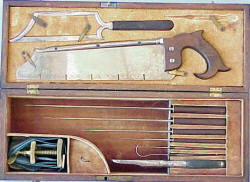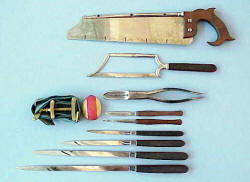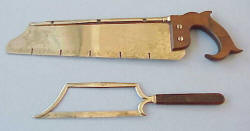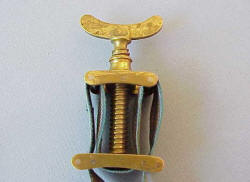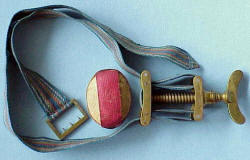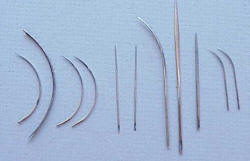A c. 1850's amputation set by Maxmillian Wocher of Cincinnati, Ohio.
Wocher was in the instrument business in various forms from 1840 to 1900.
Max (Maximilian) Wocher
surgical instrument maker
1840: E. S. Walnut btw. 4th
and 5th
1842-52: College cor.
George and Plum
1853: II College
1855: 6th btw. Vine and
Race (in Ohio Medical College building)
1856-1869: 105 W 6th (in
Ohio Medical College building) surgical and dental instrument maker
(1861) surgical and dental instrument manufacturer (1863)
Reference:
Edmonson
The lay out of the instruments in this set and the
capital saw with vertical slots is indicative of the 1850's. The vertical
slots in the saw blade are a design imitation after English maker Weiss.
A really nice early American set typical of the era prior to the Civil War.
The doctor/owner name
inscribed on the decorative brass plate is: "Dr. J. P. Wood / New
Lebanon, Ohio"
The bone forceps
differ from those of any other maker in the unusually long length of the cutting
edges of the forceps. The forceps are marked and shown in the maker
close-up photo.
All instruments,
including the tourniquet are marked "M. Wocher / Cin."
The (16 x 6 x
3) mahogany case has a central key lock and as is typical of this pre-Civil War
era, having swinging latches on the front of the case. The interior of the
case is lined with red velvet, which is faded to a light brownish color, but the
vivid red remains under the areas protected from sunlight.
Of note is the shape
of the blades of the long amputation knives. They are thin width, slender,
and curved down. This would be the transition shape from the heavier,
thick, down turned blades typical of the 1840's to the straighter blades seen
during the Civil War era.


